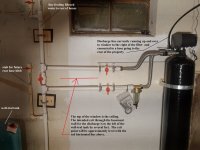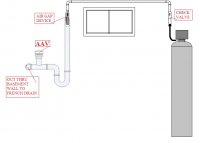Yes, your drawing is as I described. I envisioned the P trap closer to the wall so there would be no room remaining to install a Tee and riser before penetrating the wall. The check valve is not required. One suggestion is to extend the vent riser further above the pipe to reduce the potential for water to rise in the vent riser as unlikely as that may be.
With regard to code compliance, the piping part is not connected to your septic system and so does not fall under usual plumbing code. I had asked about your county requirements for discharging directly to the environment as that is a seperate matter from plumbing.
Since the discharge is plain water that will contain oxidized iron that was originally dissolved in the well water in a ferrous form that would oxidize when exposed to air anyway, I anticipate there should be no issue with that discharge, but if the unit was a softener, there could be an issue due to higher levels of sodium and chloride.
The filter sales literature does show a Fleck 5600SXT mounted on a 9" X 48" media tank. That tank dimension is appropriate for 1 cubic foot of media. Unfortunately, the media is not specified but as it states it will provide 3 micron filtration, I suspect the media may be Katalox Light.
The recommended backwash rate for KL in a 9"diameter tank is from 4.4 to 6.6 GPM with 60°F water temperature, but often, a slightly higher flow rate will be beneficial. If your water temperature is cooler than 60°F, then that will provide additional media lift and reclassification. The maximum rated backwash rate for a Fleck 5600 is 7GPM so that will likely be the max even if the drain flow restrictor were to be removed.
KL will be typically backwashed every 3-days, but that may vary depending on the iron level in your water. As the thread below includes an Arsenic issue, Ditttohead recommended to extend the KL backwash frequency to 4-7 days.
https://terrylove.com/forums/index.php?threads/arsenic-removal-water-questions.89413/#post-641786
This is what can happen to Iron reduction media with insufficient backwash frequency.
https://terrylove.com/forums/index.php?threads/iron-filter-noise.90488/#post-650780


